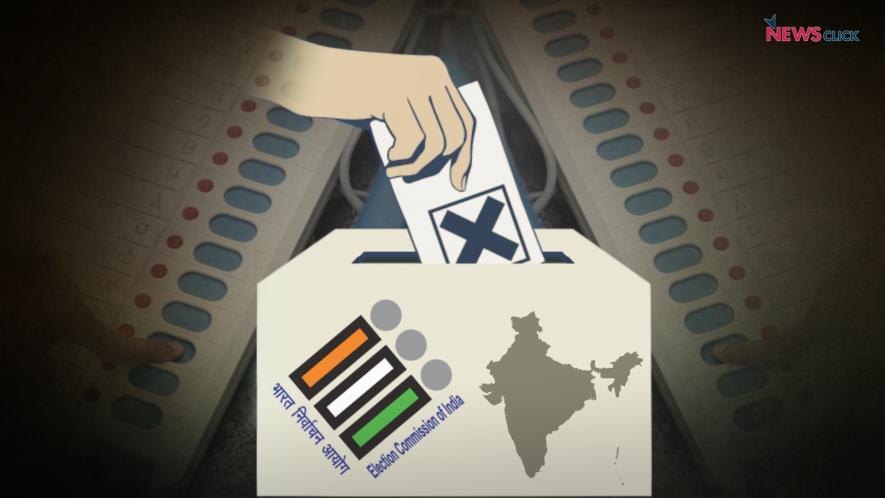Phase 6 Will Show Which Way Key States Are Tilting

The sixth and penultimate phase of polling for the Lok Sabha elections takes place today (May 25) spread over 58 constituencies in seven states and Union territories. In the preceding five phases, polling has already been completed in 428 seats while one seat (Surat) had an unopposed election.
People will vote in eight seats in north-eastern Bihar; all 10 seats in Haryana; four seats in eastern Jharkhand bordering the Jungle Mahal region of West Bengal; all seven seats of Delhi; six seats in Odisha, in a belt stretching from the ST (Scheduled Tribe) reserved seat of Keonjhar in the west to the urban conglomeration of Cuttack, Bhubaneswar and Puri on the coast; 14 seats in eastern Uttar Pradesh, from Shrawasti and Domariyaganj in the terai on the Nepal border to Prayagraj and Bhadohi in the south; and eight seats in West Bengal, covering the Jangal Mahal region with large tribal population and adjoining constituencies in the southeast, and one seat in Jammu & Kashmir (Anantnag).
BJP and its allies overwhelmingly dominated these constituencies in the 2019 General Elections. Of the 58 seats, BJP and its allies had won 45. BJP itself won 40, its Bihar allies Janata Dal (United) and Lok Jan Shakti Party won three and one seats respectively, and its Jharkhand ally All Jharkhand Students Union got one. Of the seats going to polls in this phase, BJP and allies won all eight seats of Bihar, all 10 seats in Haryana, all four seats in Jharkhand, all seven seats of the capital Delhi. Besides these, they won five of eight seats in West Bengal, nine of 14 seats in UP, and two of six seats in Odisha.
What about the remaining 12 seats? Four of these were won by the INDIA bloc of opposition parties – three by Trinamool Congress in W.Bengal and one by Samajwadi Party (SP) in UP. The remaining eight seats went to parties not in either alliance currently – four to the Bahujan Samaj Party (BSP) in UP and four to the Biju Janata Dal in Odisha. Remember that in 2019, there was an alliance between BSP and SP in UP. That contributed to the better performance of BSP. Things have changed since then, as we will see further.
BJP on Back Foot
This time round, the BJP and its allies are unlikely to repeat the dominant performance of 2019 in this phase too, just like the previous phases. The reasons are over-arching and cut across states, regions and castes. There is palpable disillusionment with Prime Minister Narendra Modi and his BJP led government at the Centre. Surveys and even ground reports in mainstream media are reluctantly admitting that the “Modi magic” is waning if not absent. Chief among the causes for this is two key economic issues: joblessness and price rise.
There is widespread perception that the Modi government has been unable to fulfil its pledge of providing 2 crore jobs every year. Similarly, relentless rise in consumer prices, especially of food items, but also of basic services like health and education, and other key necessities, like fuel, has destroyed family budgets, already suffering blows from the pandemic. These basic issues segue into myriad other problems like paper leaks and the Agniveer scheme (both linked to jobs), privatization of healthcare and education (higher fees), etc.
In addition, the aggressive propagation of toxic communal ideas throughout the past decade has reached a saturation level because – as visible in the current election campaign – this has been taken to ludicrous and repugnant levels. The Prime Minister himself reportedly talking about opposition wanting to snatch away mangalsutras and milch cattle to give to Muslims, and such other allegations are taxing the beliefs and experience of most common people, though it may enthuse the fanatic elements in the RSS/BJP fold. For common people, this is increasingly appearing as facile and transparent excuses to escape from the responsibility of failure.
Despite the concerted efforts to patch together caste alliances by bringing various caste based political parties to their fold, the BJP alliance cannot rid itself of the image of being hostile to the Dalits and Adivasis. So much so that their slogan of “ab ki baar, 400 paar” (tally should cross 400 seats in Lok Sabha) has been widely interpreted as preparation to change the Constitution of the country – something that has particularly enraged Dalit communities, while these apprehensions have been there among all sections too.
Even the image of fighting against corruption has taken a beating after the Electoral Bonds case blew open and the Supreme Court had to practically force the government and State Bank of India to reveal all details, which showed how the BJP had been receiving the lion’s share of corporate funds.
All these, and multiple local or state level factors, have come together to put the BJP on the back foot in the ongoing elections.
Factors in Different States
In UP, a key state because of its 80 Lok Sabha seats, the fact that BSP and SP are not contesting together is often seen as giving an advantage to BJP in a traditionally three-cornered contest. But reports suggest that the INDIA bloc (mainly represented by SP and Congress in UP) is emerging as the direct challenger to BJP across the board.
So, where will the BSP support base go? That is the crucial question. As mentioned earlier, the anger and disillusionment among Dalit communities indicates that a chunk of it is likely to gravitate towards INDIA bloc. Whatever Dalit votes the BJP could attract had already voted for them in the past. New accretions are unlikely now. So, while BJP does retain its strong presence in the state, its erosion is very likely compared with 2019.
In Bihar, the BJP-JDU alliance is in serious trouble going by all reports. Odisha has been the focus of BJP attention because its leadership is aware of the erosion elsewhere and it wants to compensate from states like Odisha. However, the feisty campaign of the much-respected chief minister and BJD supremo, Naveen Patnaik, appears to indicate that BJP will not find it easy going.
In Haryana, the farmers’ agitation and the consequent anger against the Modi government has created a situation where BJP is facing vociferous protests across the state. It is unlikely that the BJP can sweep all the seats there. Similarly, in Delhi, the Aam Aadmi Party-Congress alliance (as part of INDIA bloc) is posing a viable challenge to the BJP. Bengal, too, is unlikely to give BJP the kind of support it received last time.
Phase 6 is not a ‘make or break’ phase given that it has only 58 seats scattered over seven states. But each of the states is now a battleground and losses in this phase – which seem very likely – will indicate the way voting will go in each of these states. All of which may add up to a more than ever imagined.
Get the latest reports & analysis with people's perspective on Protests, movements & deep analytical videos, discussions of the current affairs in your Telegram app. Subscribe to NewsClick's Telegram channel & get Real-Time updates on stories, as they get published on our website.
























